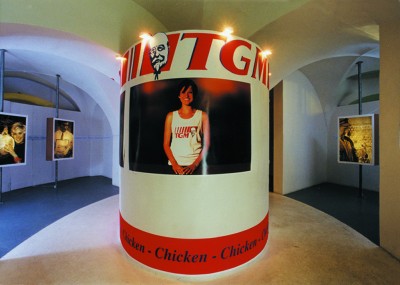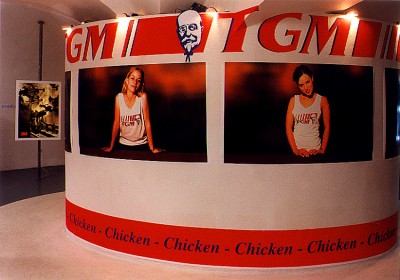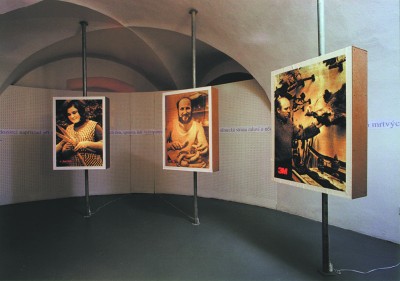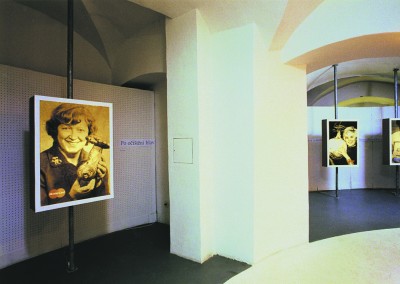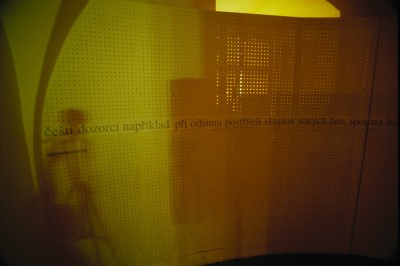TGM Chicken, 1999
Installation project, Gallery MXM, Prague, 1999
TGM Chicken was a three-level installation, created specifically for the space of the MXM Gallery. TGM is short for Tomáš Garrique Masaryk, the first president and founding father of Czechoslovakia.
Our intent was to express – with help of images and their installation – a specific feature of the Czech person. Of course one could write whole books about these things and thus any verbal explanation will be inadequate at least. Unlike the written word a piece of art sums up the expressivity of pictures (the allegory of the Czech average in the form of the reproductions from the communist “normalization” magazines), metaphor (Masaryk was as a symbol destroyed and devaluated for the means of quick national satisfaction) and the written word (authentic statements of individuals who experienced the post-war resettlement of Germans and Hungarians). The mentioned parts of the project TGM Chicken are independent and compact. And maybe even a bit solitary. With the help of their grouping they create a whole which
is more than a picture, it is a reality which can be understood only through experience.
The atmosphere of the installation gave many a feeling that could be experienced visiting a freak-show. The live exhibits living their own deranged lives, displaying their deformations with perverted joy. Through them (a resemblance of what we know) and the strange intimacy of direct light, we could be entertained and frightened at the same time. Thus it is possible to view certain (not only) Czech phenomena in history and the present. On one hand we are funny and amusing and on the other we are scary.
A wider tendency in our society strongly hints of opportunism and results in reluctance to claim responsibility. We like to appear likable and clever and we like to find Czech genius behind all big things. At the present moment we like to appear “Western“ and get rich in a quick and easy way – but without responsibility and preferably by fraud. Our historical conscience is not very clear and in all our pettiness, in one thing we are consistent: we tend to suppress it into the shadows. That’s where there is unity: in hysterical xenophobia and desperate defense of our small (and big as well) indulgences so typical for the Czech Nation. As one of the dark moments we can take the World War II aftermath. Not because of what happened decades ago but because of our present-day approach to those events. In the recent opinion polls nearly ¾ of the population supported the justification of the atrocities and the Benes decrees are therefore sacred for the ruling “elite“.
The cottage therapy
But our nation will not linger in xenophobic hysteria for long, all our neurosis have a cure: pottering at our cottages. This symbol wasn’t chosen as a specific phenomena, it merely objectifies the irresponsibility. It is one of the comic forms of the not so comic escape from reality and thus from responsibility for the great wrongs we support by being inactive (which are the original words of Jan Hus). The images of Czechs from the normalization magazine Vlasta are still relevant as they represent not only the 1970s, but also present day. Almost, that is: the difference is that while we are still the depleted totalitarian cottage do-it-yourselfers, we like to appear as successful citizens of western society. (The word appear is important here as our understanding of the First world does not permeate the admired surface.) Absurdly this shows our small-mindedness, carefully brightened with our own attractive image of ourselves.
But every light casts a shadow
We adopted the glitter of the consumer and “democratic“ society, but we are unwilling to adopt the responsibility which justifies such status. The Czech definition of democracy is unique in one way: it doesn’t include responsibility. But responsibility is not a voluntary accessory like the passenger seat airbag in your new Mercedes. It is no wonder that this light made our shadows more evident. One of them, in the darkness behind the enlightened cottage dwellers, are
post-war crimes which cannot be taken back but can be faced and defined. But this is an irritating option and when confronted, it is always possible to refer to the Indisputable Results of the War (in the words of Milos Zeman, prime minister at the time).
TGM – the mascot of Czech greatness
(TGM is short for Tomas Garrigue Masaryk, the founding father and first president of Czechoslovakia – translator’s note)
The main motif of the installation is the central stall TGM chicken. That’s where all the enlightened cottagers look to, where they are headed, leaving their shadows behind. The stall is built in the spirit of the well known global consumerist temple – the chicken buffet KFC. In this case it is by no means about KFC. It is an illustration of the “Czech path“ paved by the local permutation of selective freedom and decorated with billboards advertising “democratic society.“
It shows the bright surface of what we understand to be “western“ – but not at the expense of our identity (we will not be Germanized, Americanized, etc.) We are Czechs! We have our national pride and our culture and tradition. In our confused fervor for both (“western“ ideals and “our“ ways), we fail to understand either of them anymore. Thus we ridicule ourselves as well as our own traditions, devaluating them to a point of becoming a part of a virtual world in which we live more and more confusedly. TGM is always voted “Czech of the century“.
Interestingly most of those who opt for TGM don’t know anything about him. They decide so because it is the reliable and popular choice. TGM had been reduced to a mascot of Czech Greatness. Perhaps in the undercurrent of this mass agreement is a hidden fear that he was just too cosmopolitan for a Czech (i.e. incomprehensible) and our latter day confounded love for the Founding Father is just a subconscious effort to restitute what has surpassed us long ago. That is why TGM must be reduced to a mere symbol. In his more authentic form he would present a far too unpleasant challenge for the Czech opportunism and would become uncomfortable (in the way of the Jerzy Kosinski’s “painted bird“) just like Václav Havel in the present day. In this symbolical form, TGM is reduced to the level of advertisements for “satisfaction guaranteed” consumer products which are best embraced by the example of the fast food of i.e. Kentucky Fried Chicken.
The western limelight and glitter of something called “tradition and culture“ reduced to gestures and poses (and thus misunderstood) feeds our national pride (xenophobia) and creates a reality which is too abstract to build on. What remains is just the space for demagogy and dogmatism which can be applied well to our beaming cottage potters. They are standing there in a circle around their (misunderstood) goulash of the “western society“ and “culture and tradition“ as hypnotized rabbits and in the general glamour remains a thin thread of malevolence behind them – inconspicuous but visible – annoying with its call for responsibility.
A note to the installation: at the entrance to the gallery there are three girls smiling nicely from various exhibits. A few steps later everything seems trivial and positive. On the left is a portrait of a funny but happy mushroom-picker and a parody of KFC seems playful and superficial. Behind her is a text: “After cleaning the heads...“ – probably a show about picking mushrooms.
